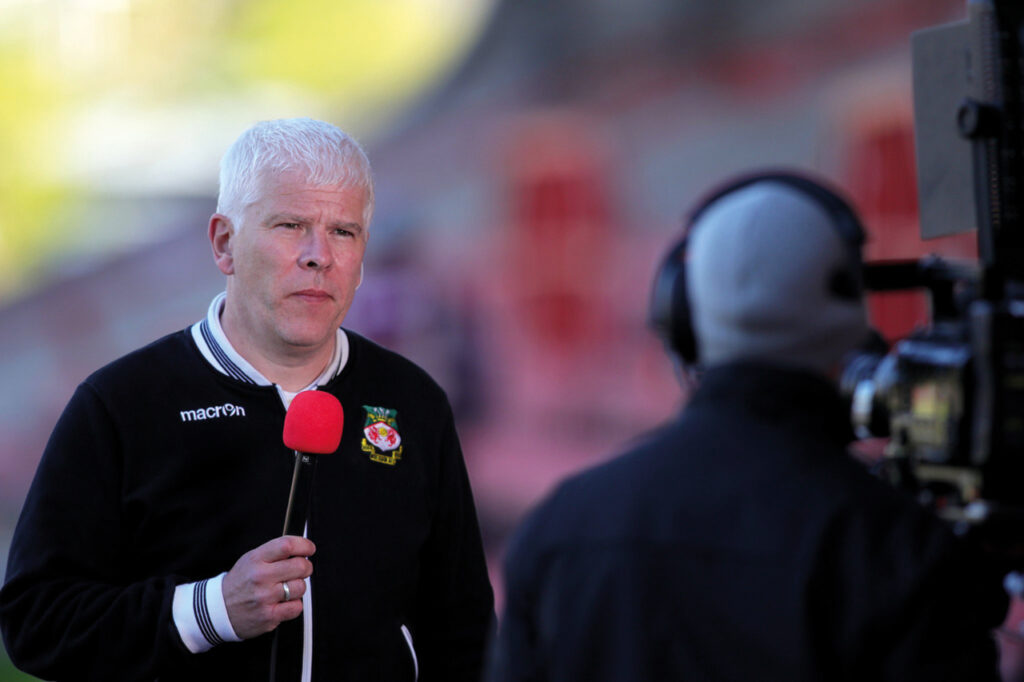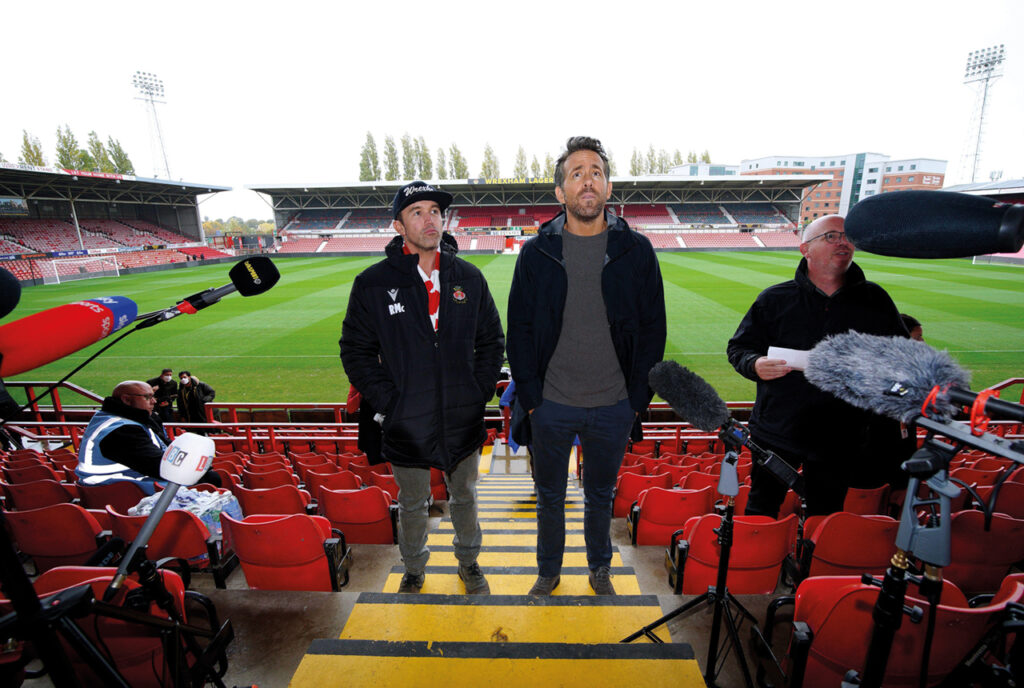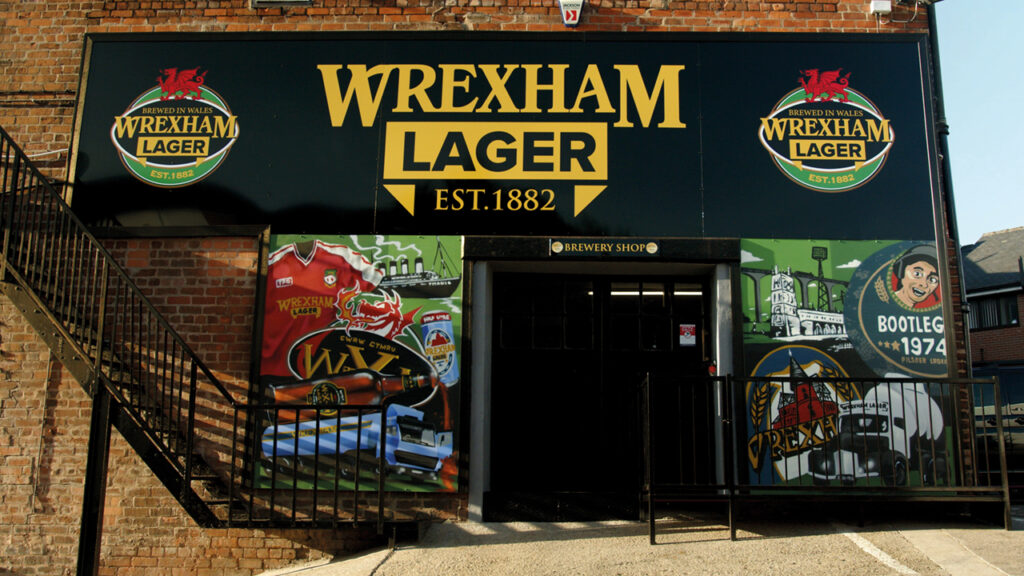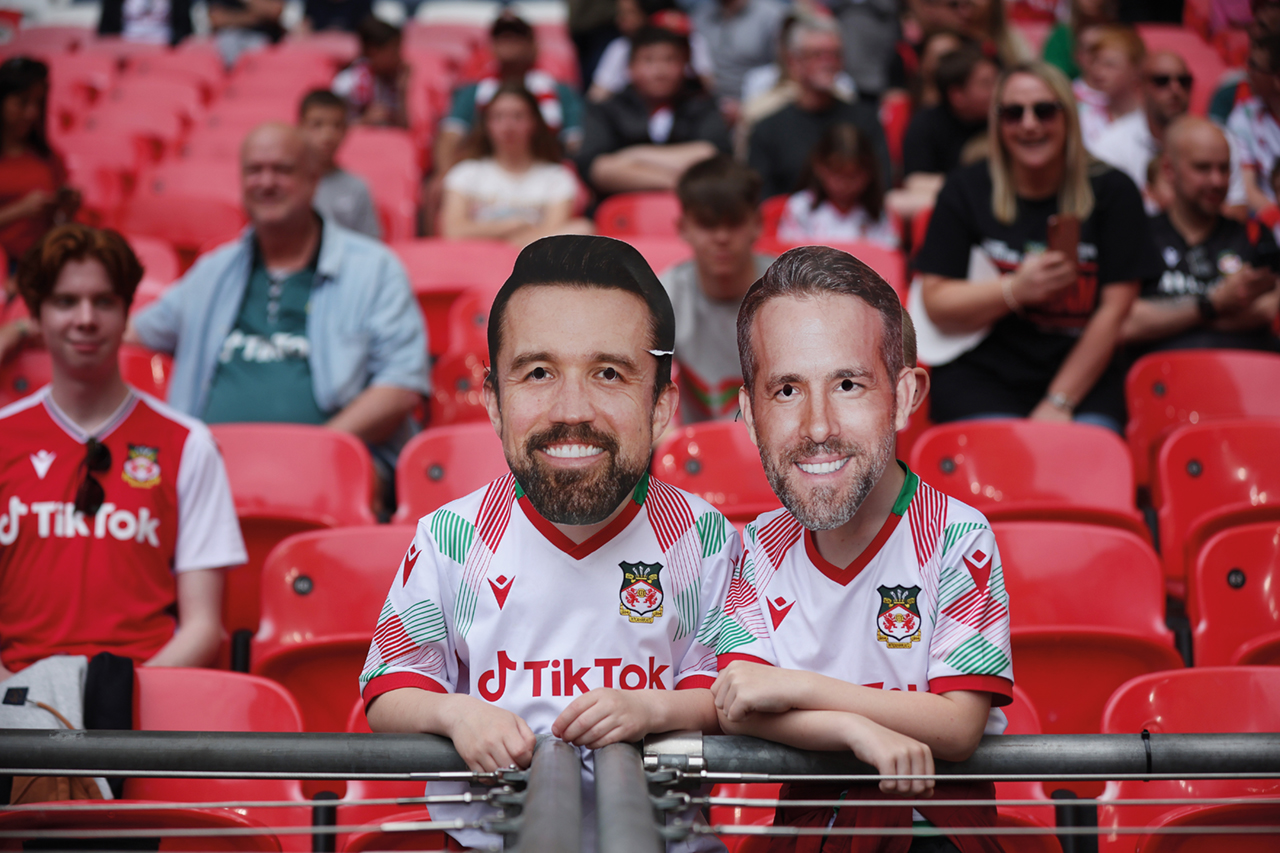Always sunny in Wrexham
Away from the mega-millions of the Premier League, a football club takeover by two Hollywood stars has won the hearts of millions.
There’s a truism about the best art inspired by sport. “Even if you’re not a fan of the sport, you’ll love it.”
That’s certainly true of Welcome to Wrexham, an 18-part story that aired on Disney Plus in autumn 2022 and is still available to stream.
A key trend of the TV on-demand era is that sports documentaries have joined the ranks of premium big budget TV shows. Audiences buy into developing, compelling narratives and identifiable characters, and sport provides emotional rollercoasters drama producers could only dream of.
Netflix’s The Last Dance, covering Michael Jordan’s Chicago Bulls, garnered near-universal acclaim. Welcome to Wrexham may not quite have quite scaled those peaks, but for a North Wales football club, relegated from the Football League in 2008, it has undoubtedly made a splash, and at a local level could have even more impact.
The story stems from Rob McElhenney, star of It’s Always Sunny in Philadelphia, teaming up with Hollywood leading man Ryan Reynolds – who he’d never even met in real life, in what now feels a very lockdown-era relationship – to buy the club.
Why? A challenge. To do something that could lift a community. For people used to winning in life, there’s an appeal in projects where winning is really, really hard.
Of course, always on the cards was making compelling TV about how competitive sport can take you from elation to utter dejection and right back up again within seconds. And although the odd segment sticks out as contrived, or there’s a cultural misinterpretation (usually around manager Phil Parkinson’s hoarse, sweary touchline diatribes), the show is a triumph.
The takeover still feels weird. People who buy football clubs used to be almost always local. That changed when TV money and the ability to “build a project” made ownership of clubs in a barely regulated economy like the UK’s attractive to the globally ambitious. Foreign ownership has been a thing in the UK for 25 years or so, and as with local bigwigs, some have been good, some bad.
In appealing to the supporters’ trust that previously owned the club, Reynolds and McElhenney’s obvious intelligence probably won the day. What do they have to gain from taking people for a ride?
Their ownership so far has been characterised by everything getting better – tidier ground, better facilities, a bit of cash for positive community projects – and, let’s not shy away from it, serious cash spent on better players. The club has to get out of the National League, back to its historic place in the Football League.

For Bryn Law, a Wrexham fan and sports media veteran, the improved profile of the team brings up a new surprise almost by the week.
“I work on Leeds United TV and my co-commentator Tony Dorigo’s wife Claire is a person who’s always been a bit interested in football, but after watching Welcome to Wrexham she’s following the scores. Tony gets home and she’ll say: ‘Wrexham won, Mullin scored.’ I’d have got them Wrexham shirts for Christmas, if I could get my hands on some.”
Wrexham merch is indeed hot property. New batches of Dragons shirts are flying off the shelves as fast as they can be stocked, with rumours of new stocks leading to flocks descending on the club shop. Inevitably, eBay opportunists are cashing in.
With the club locked in a two-horse race for top spot, and still advancing in the FA Cup, the feelgood factor is apparent.
As supporter Matt Wright says: “The pubs are busier, kids around the town are wearing Wrexham tops rather than the Premier clubs, the ground looks smarter. Loads of people who’d given up have returned – the only downside is that we can’t just pick where to sit now!”
Match tickets are indeed at a premium, a problem that will be alleviated once construction is complete on the redevelopment of the Kop, the abandoned terrace that looms through the TV show as a reminder of the dark days.
Demolition has now begun, following the securing of planning permission in November for a stand including 5,000 seats and hospitality viewing for 500, along with event, community and office space behind.
The improvement scheme is the bedrock of the “Stadium for the North” project, which aims to return international sport to an arena that, as fans of the show will know, is the world’s oldest surviving international sports venue.
Even with series one wrapped, followers have had their interest piqued still further by storylines developing in real time. Example: the brouhaha around striker Paul Mullin’s plans, revealed in an Instagram post, to wear boots emblazoned with “F*** The Tories”. The club, sitting within a currently Conservative seat, swiftly vetoed the footwear.
The commercial upswing brought about by the documentary goes beyond the club and match-day pubs. Wrexham Lager, a loyal backer of the club even before the takeover, now finds itself rubbing shoulders with global brands like TikTok as a key sponsor, and is seeing the benefit.
Law says: “My mum was queuing at the brewery shop for Christmas presents and got talking to two Americans, over for a couple of games. It wasn’t their first trip, and they’re planning to come back again. The interest is genuinely global now, and it’s happened in a relatively quick time.”
The Twitter feed of Wayne Jones, owner of the popular match-day pub the Turf Hotel and a star of Welcome to Wrexham, regularly recounts tales of newfound fans from all over, most notably from the US and Reynolds’ home country Canada.
Jones tells Big Issue North: “Rob and Ryan pre-warned me to expect tourists, and I laughed at them. But in the three months or so since the programme aired we’ve had between 1,500 to 1,800 tourists through the door – lots of Aussies, Malaysians, hundreds of Americans.
“I’d like to think this influx is helping local businesses up their game – the people of Wrexham are accommodating anyway. I know my staff have bent over backwards to welcome everybody. The only way forward for the local economy is to make people feel welcome so they keep coming back.”
It’s a far cry from the days when traditional industry dominated.

“The Wrexham area had three big industries in coal, steel and brewing, and all three suffered under Thatcher and the subsequent years, with the brewery being the last to go,” says Law. “Now the brewery’s buzzing, they’re selling beer, t-shirts, hats, you name it – so that’s one company at least that’s feeling the positive impact.
“It surely won’t be long before someone says ’Wrexham needs another hotel’ because match days are now attracting 10,000 people rather than 3,000 to 4,000.”
The traditional industries dying made the historic significance of Wrexham AFC more important still, says Law. And for all that crowds had dwindled and the club was treading water under the stewardship of the well-meaning – heroically so – but cash-poor supporters’ trust, it remained strong enough to attract a suitor, as out of the blue as the Stateside approach may have been.
A feelgood factor is one thing, but are there any tangible knock-on benefits at this stage? Rebeccah Lowry, service manager in regeneration at Wrexham Council, says the club’s momentum is combining with the city status granted as part of the 2022 platinum jubilee, and a bid for UK City of Culture status, to build a compelling story for visitors and potential investors alike.
“The programme’s been incredibly powerful in raising profile, and city status and the culture 2025 bid shows there’s a trajectory for growth,” says Lowry. “It all helps provide a climate for success.
“There’s certainly more interest in a city centre that has suffered like its counterparts. I think some property owners are realising that, instead of sitting on sleeping assets, they can do something new – there’s an air of opportunity around Wrexham now. There’s a lot of work to be done but we certainly feel optimistic.”
Lowry says what has hit home with locals is the same thing that seems to have grabbed viewers – that the Hollywood pair seem to be acting with genuine social values at heart as well as wanting to succeed on the pitch.
“From what we see, their values run deep. They’re not just treating it as a commercial opportunity. The supporters’ trust wouldn’t have sold to them if they didn’t believe that. It feels different to some big clubs where owners don’t invest in the place.”
Ultimately, she says, it’s a mutually beneficial relationship. “If Wrexham is a better-performing city, it’s better for the club. There is a good working relationship between the council and club.”
Law adds: “Wrexham as a place had been a bit down at heel. The last time it was prominent in the national news was a story on spice addicts that went viral. This has blown all that away. Now people want to be there, and people from Wrexham feel ten feet tall.”
In the documentary, McElhenney in particular is big on talking about community. A lifelong Philadelphia Eagles devotee, he both clearly loves sport and is a man who intuitively understands how a club is rooted in its community, capable of bringing people together, however tough life can be day to day.
Law says: “I’ve spoken with Rob and Ryan about the community, and they’re both at pains to say it’s not a short-term thing for them. They don’t see it as ‘here as long as series two’ but here for the duration.
“They want to play a part in Wrexham growing as somewhere people can stay and live, because it has always suffered from a lack of opportunity, if a pathway to what you want to do in your life doesn’t exist there. I was heartened to hear that.”
Wrexham AFC’s neighbour, Glyndwr University, will be vital here. It effectively saved the then-floundering club through buying the freehold of the Racecourse Ground in 2011, and in summer 2022 completed the stadium’s sale to the club, triggering the Kop project.
Both institutions sit within the £100m Wrexham Gateway regeneration area put forward – unsuccessfully – by the council for Levelling Up Fund support. Running from Wrexham General railway station, plans for the Mold Road area include more student accommodation, a transport hub, a hotel and conference/exhibition centre, and housing.
And of course, the university, currently amid a rebranding exercise, will be key in providing those opportunities.
Elen Mai Nefydd, head of Welsh medium academic development at the university, says: “Our recent open days have been really busy. We’re attracting a new demographic of students. It’s crazy to think of Wrexham on billboards in New York and Los Angeles, but it’s happened.
“We’ve recently won a tender to deliver a range of programmes for North Wales that will put students at the heart of the community – policing, clinicians, dieticians, therapists. Also, the surge of energy locally has combined with a national story, with Wales getting to the World Cup, and there’s a huge amount of interest in learning the Welsh language and seeing the benefits of bilingualism.”
What really makes Welcome to Wrexham work are the human stories from both inside the club and out. Even once the club has riches to call on, we see top-earning star striker Mullin in entirely relatable surroundings with his young family.
In a truly heartbreaking episode, we see local boy made good, midfielder Jordan Davies, and his partner Kelsey Edwards, having to deal with tragedy when their baby son Arthur is stillborn. In happier news, the couple have announced that they are expecting a baby girl this May.
We see the fans battle through life as well, with a cheery segment of the last episode being singer Michael “Scoot” Hett of local band the Declan Swans getting the all-clear following cancer treatment.
Law says: “From a sports marketing viewpoint, Welcome to Wrexham is a masterstroke. I’d praise the documentary producers for immersing themselves fully in the community. Their approach has been exemplary.
“Going behind the scenes at a football club has been done many times, but they’ve excelled by going into the community’s stories. It’s not just about football, but the trials and tribulations of the characters you find in any town like Wrexham.”
Despite missing out on promotion and the FA Trophy (spoiler alert!) last year the ending is upbeat. As McElhenney is told in the last episode: “The number one goal was to bring belief back, and you’ve done that”. A little schmaltzy, sure, but forgivable.
Promotion is pretty much a must this season though – but it’s not guaranteed. With just one automatic place available, the Red Dragons are vying with Notts County, another sleeping giant, streets ahead of the league’s other 22 clubs.
One will have to enter the choppy waters of the play-offs, where Wrexham have fallen five times in 15 years. Whatever happens this time round, it will be noticed far beyond North Wales.

Standing as both as a signifier of Wrexham’s new confidence and its history, Wrexham Lager was the first lager brewery in the UK, set up by German industrialists working in the town’s chemical industry in the 1880s.
Eventually swallowed up by the Carlsberg-Tetley empire, the brewery peaked at 1.2 million barrels a year, mostly for brands such as Skol, but was closed in the early 2000s. The Roberts family relaunched the brand in 2011, combining skills from the family’s food and drink wholesale business and director Mark Roberts’ engineering background.
He says: “For us, it’s hard to measure the impact of Rob and Ryan, because we’ve also been winning awards for our beer, picking up gold medals in Germany and the Far East. But it’s been good exposure for us, the town and for Wales, and long may it continue. People all over the world know where Wrexham is now.”
The firm has invested in top class equipment and recruited a head brewer from the site’s previous life. It has exported to South Korea, Japan, Finland and France so far.
Colleague Joss Roberts takes care of social media. He says the brand can now reach hundreds of thousands rather than tens.
“A good example is the FA Cup win at Coventry. As a sponsor, we posted a congratulatory message, which was seen by hundreds of thousands on Facebook alone.
“Our shop was on one of the closing scenes of the documentary, and within days of it airing we had triple figures of US orders for merchandise. Locally as well, having 10,000 people each match day is great for us. It’s absolutely amazing.”

Leave a reply
Your email address will not be published.